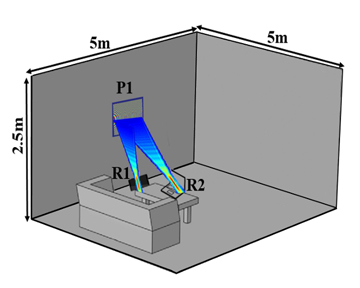
Schematic drawing of the proposed in-home wireless power transfer scheme. P1 represents the charging device. R1 and R2 are portable devices receiving a continuous charge from P1. [Image: Duke University]
Most users of wireless devices would agree that recharging devices without plugging them in as often would be a great benefit. And large moving vehicles, from unpiloted military drones to next-gen self-driving automobiles, could extend their travel times if they could draw electrical power without stopping.
Some near- and far-field wireless charging schemes do exist, but they have their own problems. Now a research group based at Duke University, USA, has devised a method for high-efficiency wireless power transfer using large-aperture metasurfaces (J. Appl. Phys., doi:10.1063/1.4973345). The metasurface-based chargers, which would have a form factor resembling a flat-screen television, could be built with existing technology.
A feasible scheme
The scientists, led by electrical engineering professor David R. Smith, analyzed the requirements for transferring power within the Fresnel zone—a source-to-receiver distance less than 2D2/λ0, where D is the aperture width of the transmitter, and λ0 is the free-space wavelength.
For a simple model, the team considered a 1-m-wide aperture beaming a gigahertz-range signal and asked how it might, using Gaussian optics, deliver power to devices within a 5-m-square room. Assuming that a practical device would have a receiving aperture of no more than 3 cm, the group found a range of frequencies that would result in a beam waist of that size, depending on the transmitter’s width.
From living room to charging room
The authors say that a metasurface aperture could provide dynamic focusing and tuning at the power source, and thus consume much less power itself than a traditional phased array. The metasurface antenna would resemble an arrangement of millions of polarizable magnetic dipoles, and could steer and focus the microwave beam to devices placed around an average room.
Although the researchers have yet to build a functioning prototype, they’ve investigated the types of materials that could go into a power-transmitting metasurface. Current silicon-based millimeter-wave technology could work, but high-electron-mobility transistors—based on gallium nitride—could handle a much higher power density than silicon chips.
Researchers from the University of Washington, USA, and the Metamaterials Commercialization Center (Bellevue, Wash., USA) also contributed to the experiments.
